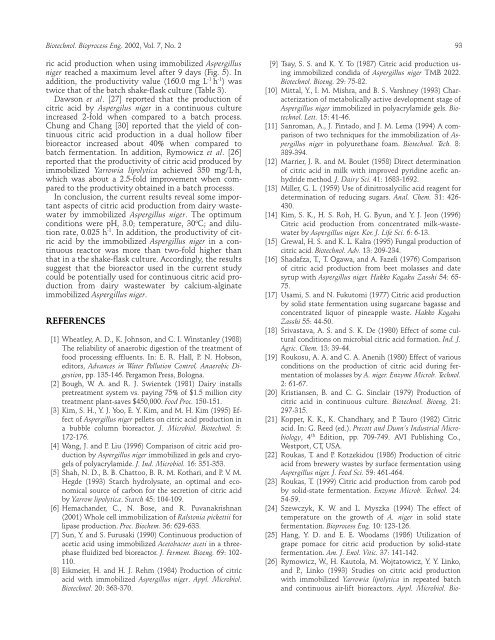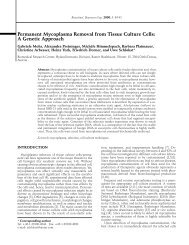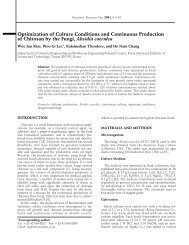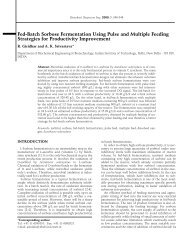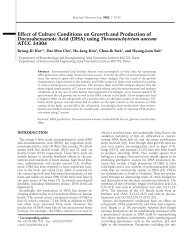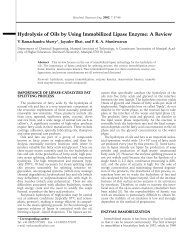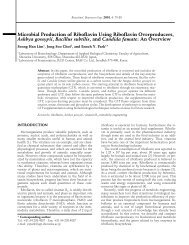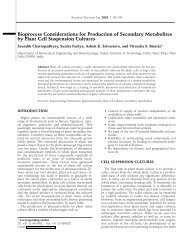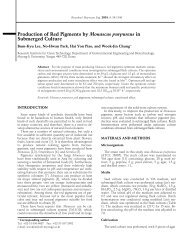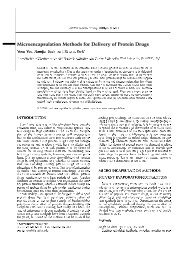Continuous Production of Citric Acid from Dairy Wastewater Using ...
Continuous Production of Citric Acid from Dairy Wastewater Using ...
Continuous Production of Citric Acid from Dairy Wastewater Using ...
Create successful ePaper yourself
Turn your PDF publications into a flip-book with our unique Google optimized e-Paper software.
Biotechnol. Bioprocess Eng. 2002, Vol. 7, No. 2 93ric acid production when using immobilized Aspergillusniger reached a maximum level after 9 days (Fig. 5). Inaddition, the productivity value (160.0 mg L -1 h -1 ) wastwice that <strong>of</strong> the batch shake-flask culture (Table 3).Dawson et al. [27] reported that the production <strong>of</strong>citric acid by Aspergilus niger in a continuous cultureincreased 2-fold when compared to a batch process.Chung and Chang [30] reported that the yield <strong>of</strong> continuouscitric acid production in a dual hollow fiberbioreactor increased about 40% when compared tobatch fermentation. In addition, Rymowicz et al. [26]reported that the productivity <strong>of</strong> citric acid produced byimmobilized Yarrowia lipolytica achieved 350 mg/L⋅h,which was about a 2.5-fold improvement when comparedto the productivity obtained in a batch processs.In conclusion, the current results reveal some importantaspects <strong>of</strong> citric acid production <strong>from</strong> dairy wastewaterby immobilized Aspergillus niger. The optimumconditions were pH, 3.0; temperature, 30 o C; and dilutionrate, 0.025 h -1 . In addition, the productivity <strong>of</strong> citricacid by the immobilized Aspergillus niger in a continuousreactor was more than two-fold higher thanthat in a the shake-flask culture. Accordingly, the resultssuggest that the bioreactor used in the current studycould be potentially used for continuous citric acid production<strong>from</strong> dairy wastewater by calcium-alginateimmobilized Aspergillus niger.REFERENCES[1] Wheatley, A. D., K. Johnson, and C. I. Winstanley (1988)The reliability <strong>of</strong> anaerobic digestion <strong>of</strong> the treatment <strong>of</strong>food processing effluents. In: E. R. Hall, P. N. Hobson,editors, Advances in Water Pollution Control, Anaerobic Digestion,pp. 135-146. Pergamon Press, Bologna.[2] Bough, W. A. and R. J. Swientek (1981) <strong>Dairy</strong> installspretreatment system vs. paying 75% <strong>of</strong> $1.5 million citytreatment plant-saves $450,000. Food Proc. 150-151.[3] Kim, S. H., Y. J. Yoo, E. Y. Kim, and M. H. Kim (1995) Effect<strong>of</strong> Aspergillus niger pellets on citric acid production ina bubble column bioreactor. J. Microbiol. Biotechnol. 5:172-176.[4] Wang, J. and P. Liu (1996) Comparison <strong>of</strong> citric acid productionby Aspergillus niger immobilized in gels and cryogels<strong>of</strong> polyacrylamide. J. Ind. Microbiol. 16: 351-353.[5] Shah, N. D., B. B. Chattoo, B. R. M. Kothari, and P. V. M.Hegde (1993) Starch hydrolysate, an optimal and economicalsource <strong>of</strong> carbon for the secretion <strong>of</strong> citric acidby Yarrow lipolytica. Starch 45: 104-109.[6] Hemachander, C., N. Bose, and R. Puvanakrishnan(2001) Whole cell immobilization <strong>of</strong> Ralstonia pickettii forlipase production. Proc. Biochem. 36: 629-633.[7] Sun, Y. and S. Furusaki (1990) <strong>Continuous</strong> production <strong>of</strong>acetic acid using immobilized Acetobacter aceti in a threephasefluidized bed bioreactor. J. Ferment. Bioeng. 69: 102-110.[8] Eikmeier, H. and H. J. Rehm (1984) <strong>Production</strong> <strong>of</strong> citricacid with immobilized Aspergillus niger. Appl. Microbiol.Biotechnol. 20: 363-370.[9] Tsay, S. S. and K. Y. To (1987) <strong>Citric</strong> acid production usingimmobilized condida <strong>of</strong> Aspergillus niger TMB 2022.Biotechnol. Bioeng. 29: 75-82.[10] Mittal, Y., I. M. Mishra, and B. S. Varshney (1993) Characterization<strong>of</strong> metabolically active development stage <strong>of</strong>Aspergillus niger immobilized in polyacrylamide gels. Biotechnol.Lett. 15: 41-46.[11] Sanroman, A., J. Pintado, and J. M. Lema (1994) A comparison<strong>of</strong> two techniques for the immobilization <strong>of</strong> Aspergillusniger in polyurethane foam. Biotechnol. Tech. 8:389-394.[12] Marrier, J. R. and M. Boulet (1958) Direct determination<strong>of</strong> citric acid in milk with improved pyridine acefic anhydridemethod. J. <strong>Dairy</strong> Sci. 41: 1683-1692.[13] Miller, G. L. (1959) Use <strong>of</strong> dinitrosalycilic acid reagent fordetermination <strong>of</strong> reducing sugars. Anal. Chem. 31: 426-430.[14] Kim, S. K., H. S. Roh, H. G. Byun, and Y. J. Jeon (1996)<strong>Citric</strong> acid production <strong>from</strong> concentrated milk-wastewaterby Aspergillus niger. Kor. J. Life Sci. 6: 6-13.[15] Grewal, H. S. and K. L. Kalra (1995) Fungal production <strong>of</strong>citric acid. Biotechnol. Adv. 13: 209-234.[16] Shadafza, T., T. Ogawa, and A. Fazeli (1976) Comparison<strong>of</strong> citric acid production <strong>from</strong> beet molasses and datesyrup with Aspergillus niger. Hakko Kogaku Zasshi 54: 65-75.[17] Usami, S. and N. Fukutomi (1977) <strong>Citric</strong> acid productionby solid state fermentation using sugarcane bagasse andconcentrated liquor <strong>of</strong> pineapple waste. Hakko KogakuZasshi 55: 44-50.[18] Srivastava, A. S. and S. K. De (1980) Effect <strong>of</strong> some culturalconditions on microbial citric acid formation. Ind. J.Agric. Chem. 13: 39-44.[19] Roukosu, A. A. and C. A. Anenih (1980) Effect <strong>of</strong> variousconditions on the production <strong>of</strong> citric acid during fermentation<strong>of</strong> molasses by A. niger. Enzyme Microb. Technol.2: 61-67.[20] Kristiansen, B. and C. G. Sinclair (1979) <strong>Production</strong> <strong>of</strong>citric acid in continuous culture. Biotechnol. Bioeng. 21:297-315.[21] Kopper, K. K., K. Chandhary, and P. Tauro (1982) <strong>Citric</strong>acid. In: G. Reed (ed.). Precott and Dunn’s Industrial Microbiology,4 th Edition, pp. 709-749. AVI Publishing Co.,Westport, CT, USA.[22] Roukas, T. and P. Kotzekidou (1986) <strong>Production</strong> <strong>of</strong> citricacid <strong>from</strong> brewery wastes by surface fermentation usingAspergillus niger. J. Food Sci. 59: 461-464.[23] Roukas, T. (1999) <strong>Citric</strong> acid production <strong>from</strong> carob podby solid-state fermentation. Enzyme Microb. Technol. 24:54-59.[24] Szewczyk, K. W. and L. Myszka (1994) The effect <strong>of</strong>temperature on the growth <strong>of</strong> A. niger in solid statefermentation. Bioprocess Eng. 10: 123-126.[25] Hang, Y. D. and E. E. Woodams (1986) Utilization <strong>of</strong>grape pomace for citric acid production by solid-statefermentation. Am. J. Enol. Vitic. 37: 141-142.[26] Rymowicz, W., H. Kautola, M. Wojtatowicz, Y. Y. Linko,and P., Linko (1993) Studies on citric acid productionwith immobilized Yarrowia lipolytica in repeated batchand continuous air-lift bioreactors. Appl. Microbiol. Bio-


